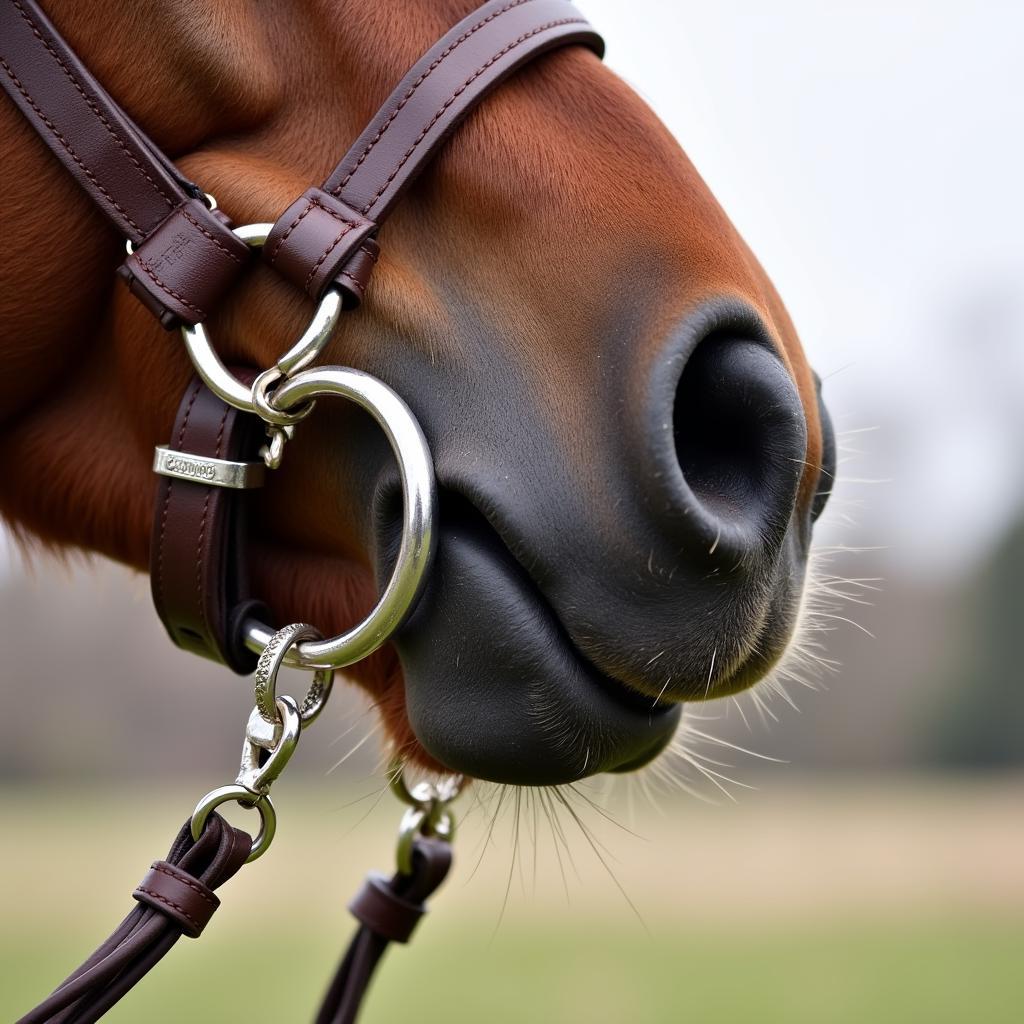Have you ever heard the term “elevator bits” for horses and wondered what it meant? In the world of equestrian equipment, choosing the right bit for your horse is crucial for communication, comfort, and safety. An elevator bit is a type of bit that serves a very specific purpose and may not be suitable for every horse and rider combination. Let’s explore the ins and outs of elevator bits, understanding their uses, benefits, and potential drawbacks.
What Exactly Are Elevator Bits?
Elevator bits, also known as “gag bits,” are a type of leverage bit that applies pressure to the poll (the area behind the horse’s ears), the bars of the mouth, and the corners of the mouth. The unique feature of these bits is the “elevator” action created by the bit rings. As the reins are engaged, the rings slide upwards, applying pressure in a specific way that encourages the horse to lift its head.
 Elevator Bit for Horse Tack
Elevator Bit for Horse Tack
When Are Elevator Bits Used?
Elevator bits are not your everyday training bits. They are typically used in specific disciplines or situations where a higher degree of control and leverage is required:
- Show Jumping: Some riders in show jumping competitions use elevator bits to encourage a more collected frame and tighter turns.
- Cross Country: The leverage provided by elevator bits can be helpful for experienced riders navigating challenging obstacles in cross country events.
- Horses with Head Carriage Issues: In some cases, elevator bits are used as a temporary training tool for horses that have a tendency to lower their heads excessively or resist upward transitions.
Understanding the Mechanics of Elevator Bits
The effectiveness of elevator bits lies in their leverage system. Here’s a breakdown of how they work:
- Upward Pull: When the rider engages the reins, the rings on the elevator bit slide upwards.
- Poll Pressure: This upward movement creates pressure on the horse’s poll, encouraging it to lift its head.
- Mouth Pressure: Simultaneously, pressure is applied to the bars and corners of the mouth, reinforcing the upward signal.
- Leverage Effect: The combination of poll and mouth pressure creates a leverage effect that can be more significant than with a simple snaffle bit.
The Potential Downsides of Elevator Bits
While elevator bits can be effective tools in the right hands, they are not without their drawbacks. It’s crucial to be aware of the potential negative aspects:
- Harshness: Due to their leverage action, elevator bits can be quite severe if used incorrectly or with excessive force.
- Risk of Injury: Improper use can lead to pain, discomfort, and even injury to the horse’s mouth, poll, and jaw.
- Training Dependency: Relying too heavily on elevator bits can hinder a horse’s training progress and mask underlying training issues.
Expert Insights
“Elevator bits are powerful tools that should only be used by experienced riders who understand the mechanics and potential risks,” says renowned equine behaviorist, Dr. Jane Miller. “It’s essential to prioritize clear communication and a solid foundation of training before even considering the use of such a bit.”
Choosing the Right Bit: A Word of Caution
Selecting the appropriate bit for your horse is a decision best made in consultation with a qualified equestrian professional. Factors to consider include:
- Horse’s Temperament and Training Level: Sensitive horses or those still in early training phases are not suited for elevator bits.
- Rider’s Experience: Elevator bits require a skilled and experienced rider who can use them with finesse and sensitivity.
- Specific Disciplinary Requirements: Certain disciplines may have rules and regulations regarding bit use in competitions.
Alternatives to Elevator Bits
If you’re looking for ways to encourage a higher head carriage without resorting to elevator bits, consider these alternatives:
- Correct Training: Proper training methods focusing on developing the horse’s back and core muscles are essential for achieving a natural and sustainable head carriage.
- Snaffle Bits: Snaffle bits, known for their gentle action, can be very effective for encouraging a rounder frame when used with correct riding techniques.
- Training Aids: Tools like training cavessons or chambons can be used temporarily and under expert guidance to encourage a specific head position.
Conclusion
Elevator bits, while useful in specific circumstances, are not a one-size-fits-all solution. They require a deep understanding of equine anatomy, biomechanics, and training principles. Always prioritize the well-being of your horse and seek guidance from experienced professionals when making decisions about bitting and equipment. Remember, clear communication and a harmonious partnership are the foundation of successful riding.
For personalized advice and assistance with your horse’s training and equipment needs, contact Justus Horses USA at 0772127271 or [email protected]. Visit our facility located at QGM2+WX2, Vị Trung, Vị Thuỷ, Hậu Giang, Việt Nam, for expert consultations and a wide range of equestrian products. Our dedicated team is available 24/7 to answer your questions and provide exceptional support.